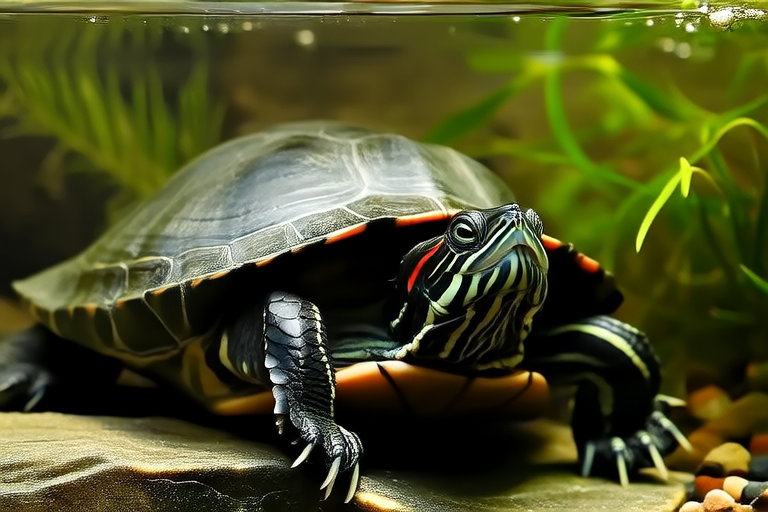The Ultimate Guide to Caring for Your Red-Eared Slider
Red-eared sliders are one of the most popular pet turtles, known for their vibrant colors and lively personalities. However, these charming reptiles require specific care to thrive in captivity. Whether you’re a first-time turtle owner or an experienced enthusiast, this guide will walk you through everything you need to know about keeping your red-eared slider happy and healthy.
Habitat Setup: Creating the Perfect Environment
A proper habitat is essential for your red-eared slider’s well-being. These aquatic turtles need both water and land areas to live comfortably.
Tank Size and Dimensions
- Minimum Tank Size: A 55-gallon tank is the absolute minimum for a single adult red-eared slider. For every additional turtle, add 20 gallons.
- Water Depth: The water should be deep enough for your turtle to swim freely but shallow enough to allow it to reach the surface easily. Aim for a depth of 1.5 to 2 times the length of the turtle’s shell.
- Basking Area: Provide a dry basking platform where your turtle can completely exit the water. This area should be large enough for your turtle to stretch out comfortably.
Filtration and Water Quality
Maintaining clean water is crucial for your turtle’s health. Use a high-quality aquarium filter designed for turtle tanks, as they produce more waste than fish. Change 25-50% of the water weekly to prevent ammonia buildup.
Temperature and Lighting
- Water Temperature: Keep the water temperature between 75°F and 80°F (24°C to 27°C).
- Basking Spot Temperature: The basking area should be heated to 85°F to 90°F (29°C to 32°C).
- UVB Lighting: Install a UVB light over the basking area to mimic natural sunlight. UVB rays are essential for calcium absorption and preventing metabolic bone disease. Replace the bulb every 6-12 months, as its effectiveness diminishes over time.
Diet and Nutrition: Feeding Your Turtle Right
Red-eared sliders are omnivores, meaning they eat both plant and animal matter. Their diet should be varied and balanced to ensure optimal health.
What to Feed
- Commercial Pellets: High-quality turtle pellets should form the base of your slider’s diet. Look for options that contain whole fish meal or shrimp meal.
- Protein Sources: Offer live or frozen foods like earthworms, crickets, bloodworms, and small fish. Avoid feeder goldfish, as they can carry parasites.
- Vegetables and Fruits: Dark leafy greens such as kale, collard greens, and dandelion leaves are excellent choices. You can also offer small amounts of fruits like apples and berries as occasional treats.
Feeding Schedule
Young sliders should be fed daily, while adults can be fed every other day. Provide only as much food as your turtle can consume in 10-15 minutes to avoid overfeeding and water contamination.
Calcium Supplementation
To support shell and bone health, dust your turtle’s food with a calcium supplement without phosphorus at least twice a week. Ensure the supplement contains vitamin D3 if your UVB lighting isn’t sufficient.
Health Care: Keeping Your Slider in Top Shape
Preventive care is key to avoiding common health issues in red-eared sliders.
Signs of Illness
- Swollen or closed eyes
- Soft or discolored shell
- Loss of appetite
- Difficulty swimming or staying buoyant
- White spots or patches on the shell
Veterinary Checkups
Schedule annual checkups with a reptile veterinarian to monitor your turtle’s health. They can perform tests to detect underlying issues early.
Common Health Problems
- Shell Rot: Caused by poor water quality or injuries, this condition requires prompt treatment with antiseptic solutions and improved tank hygiene.
- Respiratory Infections: Symptoms include wheezing, bubbles from the nose, and lethargy. Increase basking temperatures and consult a vet for antibiotics if needed.
- Metabolic Bone Disease: Prevent this by ensuring adequate UVB exposure and calcium intake.
Behavior: Understanding Your Slider’s Personality
Red-eared sliders are curious and active creatures. Observing their behavior can help you understand their needs and spot potential problems early.
Normal Behaviors
- Basking for extended periods
- Exploring the tank and interacting with objects
- Swimming energetically during feeding times
Potential Stressors
- Noisy environments
- Inadequate hiding spots
- Overcrowded tanks
Common Mistakes to Avoid
Even experienced owners can make mistakes when caring for red-eared sliders. Here are some pitfalls to watch out for:
Using Tap Water Without Treatment
Tap water often contains chlorine and chloramine, which are harmful to turtles. Always treat tap water with a reptile-safe dechlorinator before adding it to the tank.
Skipping Regular Cleaning
Neglecting tank maintenance can lead to bacterial infections and foul odors. Stick to a consistent cleaning schedule to keep your turtle’s environment pristine.
Providing Insufficient UVB Exposure
Without proper UVB lighting, your turtle cannot synthesize vitamin D3, leading to weakened bones and shells. Invest in a reliable UVB lamp and position it correctly.
Feeding Improper Foods
Avoid feeding iceberg lettuce, bread, or processed human foods, as they lack nutritional value and can cause digestive issues.
Final Thoughts: A Lifelong Commitment
Caring for a red-eared slider is a rewarding experience, but it requires dedication and attention to detail. By providing a suitable habitat, a nutritious diet, and regular veterinary care, you can ensure your turtle enjoys a long, healthy life. Remember, these fascinating creatures can live for 20-40 years, so prepare for a lifelong companionship filled with joy and discovery.
With this ultimate guide in hand, you’re ready to give your red-eared slider the best possible care. Happy turtle parenting!
